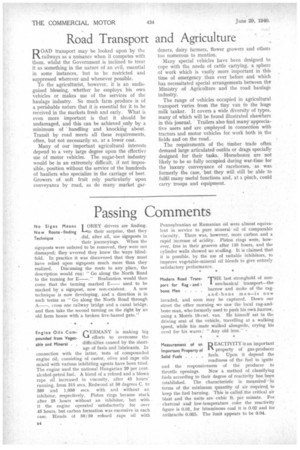Road Transport and Agriculture
Page 38

If you've noticed an error in this article please click here to report it so we can fix it.
ROAD transport may be looked upon by the railways as a nuisance when it competes with them, whilst the Government is inclined to treat it as something in the nature of an evil, essential in some instances, but to be restricted and suppressed wherever• and whenever possible.
To the agriculturist, however, it is an undisguised blessing, whether he employs his own vehicles or makes use of the services of the haulage industry. So much farm produce is of a perishable nature that it is essential for it to be received in the markets fresh and early. What is even more important is that it should be undamaged, and this can be achieved only by a minimum of handling and knocking about. Transit by road meets all these requirements, often, but not necessarily so, at a lower cost.
Many of our important agricultural interests depend to a very large degree upon the effective use of motor vehicles. The sugar-beet industry would be in an extremely difficult, if not impossible, position without the service of the hundreds of hauliers who specialize in the carriage of beet. Growers of soft fruit rely particularly upon conveyance by road, as do many market gar deners, dairy farmers, flower growers and others too numerous to mention.
Many special vehicles have been designed to cope with the needs of cattle carrying, a sphere of work which is vastly more important in this time of emergency than ever before and which has necessitated special arrangements between the Ministry of Agriculture and the road haulage industry.
The range of vehicles occupied in agricultural transport varies from the tiny van to the huge milk tanker. It covers a wide diversity of types, many of which will be found illustrated elsewhere in this journal. Trailers also find many appreciative users and are employed in connection with tractors and motor vehicles for work both in the fields and on the road.
The requirements of the timber trade often demand large articulated outfits or drags specially designed for their tasks. Horseboxes are not likely to be so fully occupied during war-time for the luxury conveyance of racehorses, as was formerly the case, but they will still be able to fulfil many useful functions and, at a pinch, could carry troops and equipment.




























































































